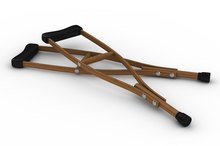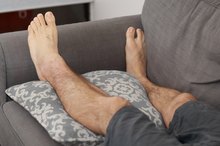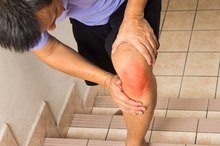How to Heal a Stretched Tendon in the Foot
Tendons are tissues that connect your muscles to your bones. They help your body to move by pulling on your bones when muscles contract. The main tendons that run through the foot and ankle are the achilles, anterior tibial, posterior tivial, flexor, extensor and peroneal tibial. When a tendon is stretched or pulled too far -- due to falls, sports injuries or wrong movements, for example -- it can become injured; symptoms include pain, swelling and stiffness. It is important to heal a stretched tendon correctly in order to prevent further damage.
Rest your stretched tendon and foot to prevent the stretch from turning into a tear. Depending on the severity of the injury, you may not be advised to put any weight on that particular foot for one to three weeks.
How to Heal From Peroneal Tendon Surgery
Learn More
Apply ice to the stretched tendon if there is swelling. Apply ice in 15-minute increments, once or twice an hour, depending on your doctor’s instructions. Reusable ice packs are convenient and prevent cold water from dripping all over your leg, foot and furniture. However, homemade ice packs, using ice cubes and a plastic bag or towel, also work just as well.
Elevate your foot, preferably above your heart, in order to help the swelling go down. Lie on a bed or sofa and prop your foot up on either the back of a sofa or a pile of pillows and blankets, and simply let it rest.
How to Rehab a Suspensory Strain
Learn More
Walk on your foot when either the pain and swelling subsides or your doctor gives you the go-ahead. Do not try to push the recovery by walking on it too soon to avoid reinjuring the tendon. Return to exercise only with your doctor’s permission.
Warnings
Visit a doctor to make sure that your tendon injury is just stretched and not torn. A torn tendon may require surgery in order for it to heel properly. Your doctor may take an ultrasound or MRI to determine the exact location and severity of the injury. To avoid making the situation worse, it is best to diagnose the injury and receive treatment as soon as possible.
Related Articles
References
- Tendonitis.net: Tendonitis/Tendinitis information and treatment options
- American Academy of Orthopedic Surgeons: Sprains and Strains: What's the Difference?
- Dr. Ben Kim: The Best Way to Treat a Sprained Ankle
- Bubra PS, Keighley G, Rateesh S, Carmody D. Posterior tibial tendon dysfunction: an overlooked cause of foot deformity. J Family Med Prim Care. 2015;4(1):26–29. doi:10.4103/2249-4863.152245
- Ling SK, Lui TH. Posterior Tibial Tendon Dysfunction: An Overview. Open Orthop J. 2017;11:714-723. doi:10.2174/1874325001711010714
- Deland JT, Page A, Sung IH, O'Malley MJ, Inda D, Choung S. Posterior tibial tendon insufficiency results at different stages. HSS J. 2006;2(2):157–160. doi:10.1007/s11420-006-9017-0
- Ikpeze TC, Brodell JD Jr, Chen RE, Oh I. Evaluation and Treatment of Posterior Tibialis Tendon Insufficiency in the Elderly Patients. Geriatr Orthop Surg Rehabil. 2019;10:2151459318821461. doi:10.1177/2151459318821461
- Wake J, Martin K. Posterior Tibial Tendon Endoscopic Debridement for Stage I and II Posterior Tibial Tendon Dysfunction. Arthrosc Tech. 2017;6(5):e2019–e2022. doi:10.1016/j.eats.2017.07.023
- Marks RM, Long JT, Ness ME, Khazzam M, Harris GF. Surgical reconstruction of posterior tibial tendon dysfunction: prospective comparison of flexor digitorum longus substitution combined with lateral column lengthening or medial displacement calcaneal osteotomy. Gait Posture. 2009;29(1):17-22. doi:10.1016/j.gaitpost.2008.05.012
- Deland JT. Adult-acquired flatfoot deformity. J Am Acad Orthop Surg. 2008 Jul;16(7):399-406.
Writer Bio
Beth Rifkin has been writing health- and fitness-related articles since 2005. Her bylines include "Tennis Life," "Ms. Fitness," "Triathlon Magazine," "Inside Tennis" and others. She holds a Bachelor of Business Administration from Temple University.








